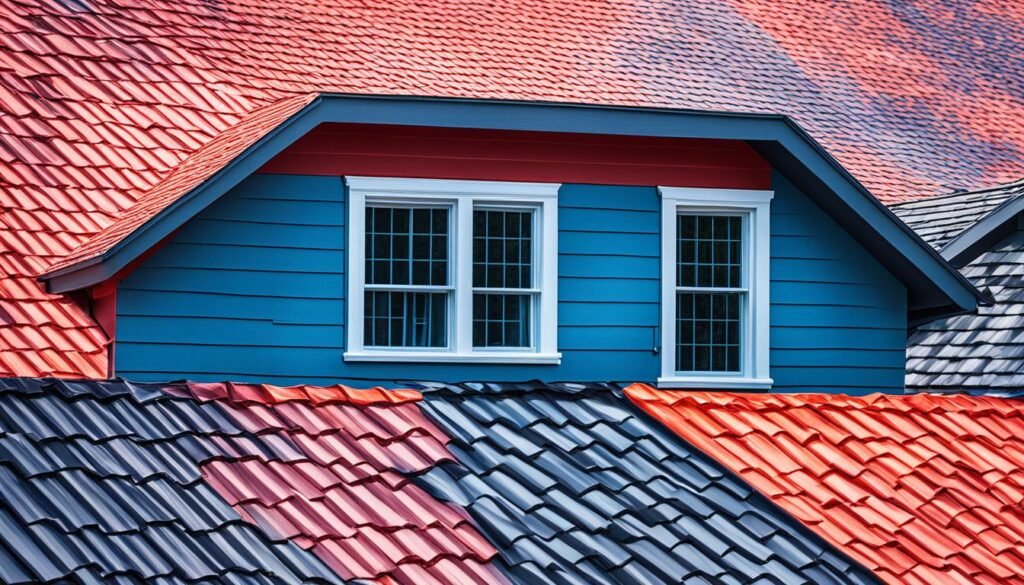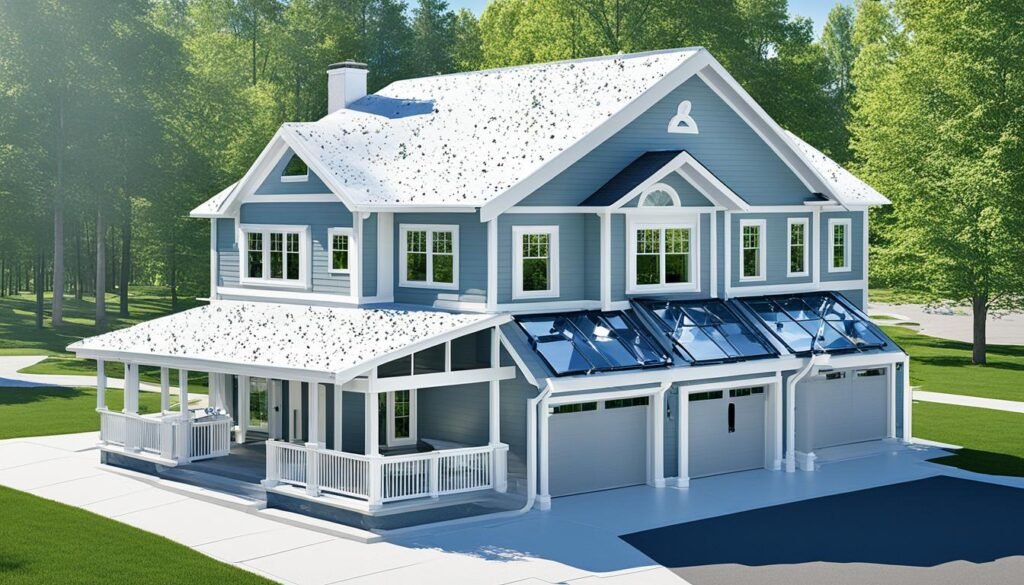Did you know that the color of your roof can make a significant difference in the temperature inside your home? It’s true! The choice of roof color can impact not only your comfort but also your energy consumption. Cool roofs, designed to reflect more sunlight and heat, can help keep your home cool even on hot summer days.
So how does roof color affect home temperature? The surface solar reflectance of the roof covering determines whether it’s cool or not. Cool roofing products, available for various roof types, can reflect a high percentage of sunlight, reducing heat absorption and keeping your home cooler. White roofing products are the coolest, reflecting about 60-90% of sunlight, while “cool colored” options reflect about 30-60% of sunlight.
Key Takeaways:
- The color of your roof can impact the temperature inside your home.
- Cool roofs are designed to reflect more sunlight and heat, keeping your home cooler.
- White roofing products reflect the highest percentage of sunlight.
- Cool colored products can effectively reflect sunlight using special pigments.
- There are cool roofing options available for different roof types.
Choosing the Right Roof Color
When it comes to deciding on the color of your roof, there’s more to consider than just aesthetics. The color you choose can have a significant impact on the temperature inside your home. By selecting a roof color that maximizes reflectivity, you can keep your home cooler and reduce energy consumption.
White roofing products are known for their high reflectivity, reflecting about 60 – 90% of sunlight. This means they effectively bounce sunlight back into the atmosphere, preventing it from entering your home and heating up the interior. Opting for white roofing products can significantly reduce the amount of heat absorbed by your roof and help keep your home cool.
However, if you prefer a colored roof, you still have options for maintaining cool temperatures. Cool colored products incorporate special pigments that are designed to preferentially reflect “near infrared” radiation. These pigments enable cool colored products to reflect about 30 – 60% of sunlight, making them much cooler than conventionally colored products.
So, while white roofing products offer the highest level of reflectivity, cool colored products can also provide effective heat reflection. By choosing the right roof color, you can ensure your home stays cool and comfortable, even during the hottest summer months.
Implementing cool colored products not only enhances your home’s ability to keep cool, but it also contributes to energy efficiency. By reducing the amount of heat absorbed through your roof, you can rely less on air conditioning, leading to lower energy consumption and cost savings.
Ultimately, the color of your roof plays a vital role in regulating the temperature inside your home. Whether you opt for white roofing products for maximum reflectivity or choose cool colored products for a touch of style, you can significantly impact the energy efficiency and comfort of your living space.
Cool Roofing Products for Different Roof Types
Different types of roofs require different cool roofing products. Choosing the right cool option for your roof type can help enhance energy efficiency and keep your home cooler. Some of the cool roofing products available for various roof types include:
Steep Roofs (Pitch > 2:12)
- Light-colored or cool-colored granules on asphalt shingles
- Naturally “cool colored” wood shingles and shakes
- Factory-colored polymer shingles
- Terra cotta clay tiles or clay tiles with light-colored glaze
- Concrete tiles with light-colored slurry or polymer coating
- Metal shingles or tiles factory coated with light- or cool-colored paint or factory surfaced with reflective mineral granules
Low-sloped Roofs (Pitch ⤠2:12)
- Membranes with light- or cool-colored pigments or light-colored ballast
- Cap sheets with reflective mineral surface or coating
- Modified bitumen sheet membranes with reflective mineral surface or coating
- Spray polyurethane foam roofs with reflective protective coatings
These cool roofing products are specifically designed to reflect more sunlight and heat, keeping your home cooler and reducing energy consumption. By choosing the right cool option for your roof type, you can improve energy efficiency and create a more comfortable living environment.
The Role of Roof Color in Home Temperature
The color of your roof plays a crucial role in determining the temperature inside your home. Light colors, such as white or light gray, help to keep the interior cooler by reflecting the sun’s rays. On the other hand, dark colors absorb more heat, leading to higher temperatures in your roof and upper floors.
While the temperature difference between light-colored and dark-colored roofs may only be a few degrees, it can have a significant impact on your energy costs. Lighter color roofs, especially those with cool coatings or reflective paint, can deflect more heat away from your home, reducing the workload on your air conditioning system.
| Roof Color | Impact on Home Temperature |
|---|---|
| Light colors (e.g., white, light gray) | Reflect the sun’s rays, keep the interior cooler |
| Dark colors (e.g., black, dark brown) | Absorb more heat, result in higher temperatures |

By choosing a lighter color for your roof, you can help to maintain a comfortable temperature inside your home and reduce your reliance on artificial cooling systems. Additionally, cool coatings and reflective paint can enhance the heat-reflecting properties of your roof, further improving energy efficiency.
It’s important to note that the impact of roof color on home temperature is just one factor to consider. Proper insulation and ventilation are also essential for maintaining a cool and comfortable living environment. By combining these strategies, you can optimize your home’s energy efficiency and create a more sustainable living space.
Considerations for Keeping Your Home Cool
While the color of your roof plays a role in maintaining a cool home, there are other essential considerations to keep in mind. Ventilation, insulation, and energy efficiency are key factors that contribute to the overall comfort and temperature control of your home.
Ventilation: Proper attic ventilation is crucial for creating a healthy airflow and preventing heat buildup. It allows hot air to escape, ensuring that your home stays cool. Without adequate ventilation, trapped hot air can raise the temperature inside your home, making it more difficult to maintain a comfortable living environment.
Insulation: Insulation acts as a barrier against heat transfer, preventing the cool air in your home from escaping to the attic. It helps to maintain a consistent temperature throughout your living spaces, reducing the need for excessive cooling. Adequate insulation also plays a role in keeping your home warm during cold winter months by preventing heat loss.
Energy Efficiency: Maximizing energy efficiency is essential for reducing your carbon footprint and optimizing cost savings. Choosing energy-efficient roofing materials and insulation can significantly impact the overall energy consumption of your home. By reducing the reliance on cooling systems, you can lower your energy bills while ensuring a comfortable living environment.
“Proper attic ventilation and insulation are key components in maintaining a cool home and optimizing energy efficiency.” – Mark Johnson, Home Improvement Expert
Comparison of Different Ventilation and Insulation Options
| Ventilation Options | Insulation Options |
|---|---|
| Natural Ventilation (Windows, Vents) | Fiberglass Insulation |
| Ridge Ventilation | Cellulose Insulation |
| Soffit Ventilation | Spray Foam Insulation |
| Turbine Ventilation | Rigid Foam Insulation |
Choosing the right combination of ventilation and insulation methods depends on various factors such as climate, building design, and personal preference. Consulting with a professional roofer or home improvement expert can help you determine the most suitable options for your specific needs.
By considering factors such as ventilation, insulation, and energy efficiency in addition to roof color, you can create a cool and comfortable home environment that promotes optimal energy usage and cost savings.

Conclusion
In conclusion, the color of your roof plays a vital role in determining the temperature inside your home. Opting for cool roofs, engineered to reflect sunlight and heat, can significantly contribute to maintaining a cooler home and improving energy efficiency. It is crucial to select the right roof color, taking into consideration factors like reflectivity and cool coatings, to amplify the cooling effects. However, it’s essential to note that roof color is just one piece of the puzzle in creating a cool home environment.
To achieve optimal comfort and sustainability, it is equally important to address other aspects such as proper ventilation, insulation, and energy-efficient practices. Adequate ventilation allows hot air to escape, preventing heat buildup, while insulation helps in preserving cool air in the lower parts of your home and preventing its escape to the attic.
By adopting a holistic approach that encompasses roof color, ventilation, insulation, and energy efficiency, you can create a serene and eco-friendly living space. So, when it comes to keeping your home cool, remember that every element matters, and together they contribute to a harmonious and comfortable environment.
FAQ
How does the color of my roof impact the temperature inside my home?
The color of your roof can have a significant impact on the temperature inside your home. Cool roofs are designed to reflect more sunlight and heat, keeping the interior cooler.
What determines whether a roof is considered cool or not?
The surface solar reflectance of the roof covering determines whether the roof is cool or not. Cool roofing products are available for nearly all types of roofs.
Do cool roofs cost more than conventional roofing products?
Cool roofing products usually cost no more than conventional roofing products, so you can enhance energy efficiency and home comfort without breaking the bank.
Which roof color reflects the most sunlight?
White roofing products have the highest reflectivity, reflecting about 60 – 90% of sunlight. These are the coolest options for keeping your home comfortable.
Are there cool options for different types of roofs?
Yes, there are cool options for asphalt shingles, wood shingles, polymer shingles, clay tiles, concrete tiles, metal shingles or tiles, single-ply membranes, built-up roofs, spray polyurethane foam roofs, and green roofs.
Can cool colored products also reflect sunlight effectively?
Yes, cool colored products use special pigments that preferentially reflect “near infrared” radiation. These products typically reflect about 30 – 60% of sunlight and stay cooler than conventionally colored products.
How does roof color impact the temperature inside my home?
Light colors, such as white or light gray, reflect the sun’s rays and help to keep the interior cooler. Dark colors absorb more heat and can result in higher temperatures inside your home.
What other factors should I consider for keeping my home cool?
Proper attic ventilation, insulation, and energy-efficient practices are also important for maintaining a cool home. They work in tandem with roof color to ensure optimal comfort and cost savings.
